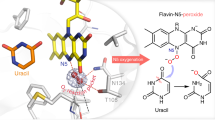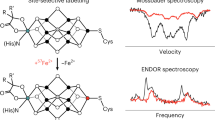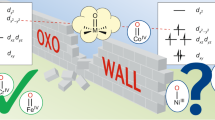Abstract
Oxidase and oxygenase enzymes allow the use of relatively unreactive O2 in biochemical reactions. Many of the mechanistic strategies used in nature for this key reaction are represented within the 2-histidine-1-carboxylate facial triad family of non-heme Fe(II)-containing enzymes. The open face of the metal coordination sphere opposite the three endogenous ligands participates directly in the reaction chemistry. Here, data from several studies are presented showing that reductive O2 activation within this family is initiated by substrate (and in some cases cosubstrate or cofactor) binding, which then allows coordination of O2 to the metal. From this starting point, the O2 activation process and the reactions with substrates diverge broadly. The reactive species formed in these reactions have been proposed to encompass four oxidation states of iron and all forms of reduced O2 as well as several of the reactive oxygen species that derive from O-O bond cleavage.
This is a preview of subscription content, access via your institution
Access options
Subscribe to this journal
Receive 12 print issues and online access
$259.00 per year
only $21.58 per issue
Buy this article
- Purchase on Springer Link
- Instant access to full article PDF
Prices may be subject to local taxes which are calculated during checkout






Similar content being viewed by others
References
Ozer, A. & Bruick, R.K. Non-heme dioxygenases: cellular sensors and regulators jelly rolled into one? Nat. Chem. Biol. 3, 144–153 (2007).
Kirk, T.K. in Microbial Degradation of Organic Compounds Vol. 13 (ed. Gibson, D.T.) 399–438 (Marcel Dekker, Inc., New York, 1984).
Hakemian, A.S. & Rosenzweig, A.C. The biochemistry of methane oxidation. Annu. Rev. Biochem. 76, 223–241 (2007).
Gibson, D.T. & Parales, R.E. Aromatic hydrocarbon dioxygenases in environmental biotechnology. Curr. Opin. Biotechnol. 11, 236–243 (2000).
Baldwin, J.E. & Abraham, E. Biosynthesis of penicillins and cephalosporins. Nat. Prod. Rep. 5, 129–145 (1988).
Kershaw, N.J., Caines, M.E.C., Sleeman, M.C. & Schofield, C.J. The enzymology of clavam and carbapenem biosynthesis. Chem. Commun. (Camb) 4251–4263 (2005).
Pau, M.Y.M., Lipscomb, J.D. & Solomon, E.I. Substrate activation for O2 reactions by oxidized metal centers in biology. Proc. Natl. Acad. Sci. USA 104, 18355–18362 (2007).
Hayaishi, O., Katagiri, H. & Rothberg, S. Mechanism of the pyrocatechase reaction. J. Am. Chem. Soc. 77, 5450–5451 (1955).
Holm, R.H., Kennepohl, P. & Solomon, E.I. Structural and functional aspects of metal sites in biology. Chem. Rev. 96, 2239–2314 (1996).
Costas, M., Mehn, M.P., Jensen, M.P. & Que, L. Jr. Dioxygen activation at mononuclear nonheme iron active sites: enzymes, models, and intermediates. Chem. Rev. 104, 939–986 (2004).
Siegbahn, P.E.M. & Borowski, T. Modeling enzymatic reactions involving transition metals. Acc. Chem. Res. 39, 729–738 (2006).
Nam, W. Dioxygen activation by metalloenzymes and models. Acc. Chem. Res. 40, 465 (2007).
Hegg, E.L. & Que, L. The 2-His-1-carboxylate facial triad: an emerging structural motif in mononuclear non-heme iron(II) enzymes. Eur. J. Biochem. 250, 625–629 (1997).
Arciero, D.M. & Lipscomb, J.D. Binding of 17O-labeled substrate and inhibitors to protocatechuate 4,5-dioxygenase-nitrosyl complex. Evidence for direct substrate binding to the active site Fe2+ of extradiol dioxygenases. J. Biol. Chem. 261, 2170–2178 (1986).
Sato, N. et al. Crystal structures of the reaction intermediate and its homologue of an extradiol-cleaving catecholic dioxygenase. J. Mol. Biol. 321, 621–636 (2002).
Boerjan, W., Ralph, J. & Baucher, M. Lignin biosynthesis. Annu. Rev. Plant Biol. 54, 519–549 (2003).
Dagley, S. in The Bacteria Vol. 10 (ed. Sokatch, J.R.) 527–556 (Academic Press, New York, 1986).
Lipscomb, J.D. & Orville, A.M. Mechanistic aspects of dihydroxybenzoate dioxygenases. Met. Ions Biol. Syst. 28, 243–298 (1992).
Gibson, D.T. in Microbial Metabolism and the Carbon Cycle (eds. Hagedorn, S.R., Hanson, R.S. & Kunz, D.A.) 33–58 (Harwood Academic Publishers, Chur, Switzerland, 1988).
Vaillancourt, F.H., Bolin, J.T. & Eltis, L.D. The ins and outs of ring-cleaving dioxygenases. Crit. Rev. Biochem. Mol. Biol. 41, 241–267 (2006).
Han, S., Eltis, L.D., Timmis, K.N., Muchmore, S.W. & Bolin, J.T. Crystal structure of the biphenyl-cleaving extradiol dioxygenase from a PCB-degrading pseudomonad. Science 270, 976–980 (1995).
Senda, T. et al. Three-dimensional structures of free form and two substrate complexes of an extradiol ring-cleavage type dioxygenase, the BphC enzyme from Pseudomonas sp. strain KKS102. J. Mol. Biol. 255, 735–752 (1996).
Shu, L. et al. X-ray absorption spectroscopic studies of the Fe(II) active site of catechol 2,3-dioxygenase. Implications for the extradiol cleavage mechanism. Biochemistry 34, 6649–6659 (1995).
Bugg, T.D.H. Dioxygenase enzymes: catalytic mechanisms and chemical models. Tetrahedron 59, 7075–7101 (2003).
Kovaleva, E.G., Neibergall, M.B., Chakrabarty, S. & Lipscomb, J.D. Finding intermediates in the O2 activation pathways of non-heme iron oxygenases. Acc. Chem. Res. 40, 475–483 (2007).
Sanvoisin, J., Langley, G.J. & Bugg, T.D.H. Mechanism of extradiol catechol dioxygenases: evidence for a lactone intermediate in the 2,3-dihydroxyphenylpropionate 1,2-dioxygenase reaction. J. Am. Chem. Soc. 117, 7836–7837 (1995).
Deeth, R.J. & Bugg, T.D.H. A density functional investigation of the extradiol cleavage mechanism in non-heme iron catechol dioxygenases. J. Biol. Inorg. Chem. 8, 409–418 (2003).
Siegbahn, P.E.M. & Haeffner, F. Mechanism for catechol ring-cleavage by non-heme iron extradiol dioxygenases. J. Am. Chem. Soc. 126, 8919–8932 (2004).
Kovaleva, E.G. & Lipscomb, J.D. Crystal structures of Fe2+ dioxygenase superoxo, alkylperoxo, and bound product intermediates. Science 316, 453–457 (2007).
Groce, S.L. & Lipscomb, J.D. Aromatic ring cleavage by homoprotocatechuate 2,3-dioxygenase: role of His200 in the kinetics of interconversion of reaction cycle intermediates. Biochemistry 44, 7175–7188 (2005).
Groce, S.L. & Lipscomb, J.D. Conversion of extradiol aromatic ring-cleaving homoprotocatechuate 2,3-dioxygenase into an intradiol cleaving enzyme. J. Am. Chem. Soc. 125, 11780–11781 (2003).
Gilbson, D.T. Microbial degradation of aromatic compounds. Science 161, 1093–1097 (1968).
Ensley, B.D., Gibson, D.T. & Laborde, A.L. Oxidation of naphthalene by a multicomponent enzyme system from Pseudomonas sp. strain NCIB 9816. J. Bacteriol. 149, 948–954 (1982).
Kauppi, B. et al. Structure of an aromatic-ring-hydroxylating dioxygenase-naphthalene 1,2-dioxygenase. Structure 6, 571–586 (1998).
Carredano, E. et al. Substrate binding site of naphthalene 1,2-dioxygenase: functional implications of indole binding. J. Mol. Biol. 296, 701–712 (2000).
Furusawa, Y. et al. Crystal structure of the terminal oxygenase component of biphenyl dioxygenase derived from Rhodococcus sp. strain RHA1. J. Mol. Biol. 342, 1041–1052 (2004).
Friemann, R. et al. Structural insight into the dioxygenation of nitroarene compounds: the crystal structure of nitrobenzene dioxygenase. J. Mol. Biol. 348, 1139–1151 (2005).
Dong, X. et al. Crystal structure of the terminal oxygenase component of cumene dioxygenase from Pseudomonas fluorescens IP01. J. Bacteriol. 187, 2483–2490 (2005).
Pavel, E.G., Martins, L.J., Ellis, W.R. Jr. & Solomon, E.I. Magnetic circular dichroism studies of exogenous ligand and substrate binding to the non-heme ferrous active site in phthalate dioxygenase. Chem. Biol. 1, 173–183 (1994).
Ohta, T., Chakrabarty, S., Lipscomb, J.D. & Solomon, E.I. Near-IR MCD of the non-heme ferrous active site in naphthalene 1,2-dioxygenase: correlation to crystallography and structural insight into the mechanism of Rieske dioxygenases. J. Am. Chem. Soc. published online, doi:10.1021/ja074769o (12 January 2008).
Wolfe, M.D., Parales, J.V., Gibson, D.T. & Lipscomb, J.D. Single turnover chemistry and regulation of O2 activation by the oxygenase component of naphthalene 1,2-dioxygenase. J. Biol. Chem. 276, 1945–1953 (2001).
Wolfe, M.D. et al. Benzoate 1,2-dioxygenase from Pseudomonas putida: single turnover kinetics and regulation of a two-component Rieske dioxygenase. Biochemistry 41, 9611–9626 (2002).
Beharry, Z.M. et al. Histidine ligand protonation and redox potential in the Rieske dioxygenases: role of a conserved aspartate in anthranilate 1,2-dioxygenase. Biochemistry 42, 13625–13636 (2003).
Tarasev, M., Rhames, F. & Ballou, D.P. Rates of the phthalate dioxygenase reaction with oxygen are dramatically increased by interactions with phthalate and phthalate oxygenase reductase. Biochemistry 43, 12799–12808 (2004).
Wallar, B.J. & Lipscomb, J.D. Dioxygen activation by enzymes containing binuclear non-heme iron clusters. Chem. Rev. 96, 2625–2657 (1996).
Groves, J.T. High-valent iron in chemical and biological oxidations. J. Inorg. Biochem. 100, 434–447 (2006).
Tarasev, M. & Ballou, D.P. Chemistry of the catalytic conversion of phthalate into its cis-dihydrodiol during the reaction of oxygen with the reduced form of phthalate dioxygenase. Biochemistry 44, 6197–6207 (2005).
Bassan, A., Blomberg, M.R.A. & Siegbahn, P.E.M. A theoretical study of the cis-dihydroxylation mechanism in naphthalene 1,2-dioxygenase. J. Biol. Inorg. Chem. 9, 439–452 (2004).
Bassan, A., Blomberg, M.R.A., Siegbahn, P.E.M. & Que, L. Jr. Two faces of a biomimetic non-heme HO-Fe(V)=O oxidant: olefin epoxidation versus cis-dihydroxylation. Angew. Chem. Int. Ed. 44, 2939–2941 (2005).
Wolfe, M.D. & Lipscomb, J.D. Hydrogen peroxide-coupled cis-diol formation catalyzed by naphthalene 1,2-dioxygenase. J. Biol. Chem. 278, 829–835 (2003).
Neibergall, M.B., Stubna, A., Mekmouche, Y., Münck, E. & Lipscomb, J.D. Hydrogen peroxide dependent cis-dihydroxylation of benzoate by fully oxidized benzoate 1,2-dioxygenase. Biochemistry 46, 8004–8016 (2007).
Karlsson, A. et al. Crystal structure of naphthalene dioxygenase: side-on binding of dioxygen to iron. Science 299, 1039–1042 (2003).
Chakrabarty, S., Austin, R.N., Deng, D., Groves, J.T. & Lipscomb, J.D. Radical intermediates in monooxygenase reactions of Rieske dioxygenases. J. Am. Chem. Soc. 129, 3514–3515 (2007).
Hausinger, R.P. Fe(II)/alpha-ketoglutarate-dependent hydroxylases and related enzymes. Crit. Rev. Biochem. Mol. Biol. 39, 21–68 (2004).
Elkins, J.M. et al. X-ray crystal structure of Escherichia coli taurine/alpha-ketoglutarate dioxygenase complexed to ferrous iron and substrates. Biochemistry 41, 5185–5192 (2002).
Valegard, K. et al. Structure of a cephalosporin synthase. Nature 394, 805–809 (1998).
Clifton, I.J., Hsueh, L.C., Baldwin, J.E., Harlos, K. & Schofield, C.J. Structure of proline 3-hydroxylase. Evolution of the family of 2-oxoglutarate dependent oxygenases. Eur. J. Biochem. 268, 6625–6636 (2001).
Clifton, I.J. et al. Crystal structure of carbapenem synthase (CarC). J. Biol. Chem. 278, 20843–20850 (2003).
Ryle, M.J., Padmakumar, R. & Hausinger, R.P. Stopped-flow kinetic analysis of Escherichia coli taurine/alpha-ketoglutarate dioxygenase: interactions with alpha-ketoglutarate, taurine, and oxygen. Biochemistry 38, 15278–15286 (1999).
Price, J.C., Barr, E.W., Tirupati, B., Bollinger, J.M. Jr. & Krebs, C. The first direct characterization of a high-valent iron intermediate in the reaction of an α-ketoglutarate-dependent dioxygenase: a high-spin Fe(IV) complex in taurine alpha-ketoglutarate dioxygenase (TauD) from Escherichia coli. Biochemistry 42, 7497–7508 (2003).
Sturgeon, B.E. et al. Reconsideration of X, the diiron intermediate formed during cofactor assembly in E. coli ribonucleotide reductase. J. Am. Chem. Soc. 118, 7551–7557 (1996).
Lee, S.-K., Fox, B.G., Froland, W.A., Lipscomb, J.D. & Münck, E. A transient intermediate of the methane monooxygenase catalytic cycle containing a FeIVFeIV cluster. J. Am. Chem. Soc. 115, 6450–6451 (1993).
Price, J.C., Barr, E.W., Hoffart, L.M., Krebs, C. & Bollinger, J.M. Jr. Kinetic dissection of the catalytic mechanism of taurine:alpha-ketoglutarate dioxygenase (TauD) from Escherichia coli. Biochemistry 44, 8138–8147 (2005).
Price, J.C., Barr, E.W., Glass, T.E., Krebs, C. & Bollinger, J.M. Jr. Evidence for hydrogen abstraction from C1 of taurine by the high-spin Fe(IV) intermediate detected during oxygen activation by taurine:alpha-ketoglutarate dioxygenase (TauD). J. Am. Chem. Soc. 125, 13008–13009 (2003).
Proshlyakov, D.A., Henshaw, T.F., Monterosso, G.R., Ryle, M.J. & Hausinger, R.P. Direct detection of oxygen intermediates in the non-heme Fe enzyme taurine/alpha -ketoglutarate dioxygenase. J. Am. Chem. Soc. 126, 1022–1023 (2004).
Riggs-Gelasco, P.J. et al. EXAFS spectroscopic evidence for an Fe:O unit in the Fe(IV) intermediate observed during oxygen activation by taurine:alpha -ketoglutarate dioxygenase. J. Am. Chem. Soc. 126, 8108–8109 (2004).
Johnson-Winters, K., Purpero, V.M., Kavana, M. & Moran, G.R. Accumulation of multiple intermediates in the catalytic cycle of (4-hydroxyphenyl)pyruvate dioxygenase from Streptomyces avermitilis. Biochemistry 44, 7189–7199 (2005).
Galonic, D.P., Vaillancourt, F.H. & Walsh, C.T. Halogenation of unactivated carbon centers in natural product biosynthesis: trichlorination of leucine during barbamide biosynthesis. J. Am. Chem. Soc. 128, 3900–3901 (2006).
Blasiak, L.C., Vaillancourt, F.H., Walsh, C.T. & Drennan, C.L. Crystal structure of the non-heme iron halogenase SyrB2 in syringomycin biosynthesis. Nature 440, 368–371 (2006).
Galonic, D.P., Barr, E.W., Walsh, C.T., Bollinger, J.M. Jr. & Krebs, C. Two interconverting Fe(IV) intermediates in aliphatic chlorination by the halogenase CytC3. Nat. Chem. Biol. 3, 113–116 (2007).
Fujimori, D.G. et al. Spectroscopic evidence for a high-spin Br-Fe(IV)-oxo intermediate in the alpha-ketoglutarate-dependent halogenase CytC3 from Streptomyces. J. Am. Chem. Soc. 129, 13408–13409 (2007).
Fitzpatrick, P.F. Tetrahydropterin-dependent amino acid hydroxylases. Annu. Rev. Biochem. 68, 355–381 (1999).
Andersen, O.A., Stokka, A.J., Flatmark, T. & Hough, E. 2.0 Å resolution crystal structures of the ternary complexes of human phenylalanine hydroxylase catalytic domain with tetrahydrobiopterin and 3-(2-thienyl)-alanine or -norleucine: substrate specificity and molecular motions related to substrate binding. J. Mol. Biol. 333, 747–757 (2003).
Pavon, J.A. & Fitzpatrick, P.F. Insights into the catalytic mechanisms of phenylalanine and tryptophan hydroxylase from kinetic isotope effects on aromatic hydroxylation. Biochemistry 45, 11030–11037 (2006).
Eser, B.E. et al. Direct spectroscopic evidence for a high-spin Fe(IV) intermediate in tyrosine hydroxylase. J. Am. Chem. Soc. 129, 11334–11335 (2007).
Bassan, A., Blomberg, M.R.A. & Siegbahn, P.E.M. Mechanism of aromatic hydroxylation by an activated FeIV=O core in tetrahydrobiopterin-dependent hydroxylases. Chem. Eur. J. 9, 4055–4067 (2003).
Koehntop, K.D., Emerson, J.P. & Que, L. Jr. The 2-His-1-carboxylate facial triad: a versatile platform for dioxygen activation by mononuclear non-heme iron(II) enzymes. J. Biol. Inorg. Chem. 10, 87–93 (2005).
Clifton, I.J. et al. Structural studies on 2-oxoglutarate oxygenases and related double-stranded beta -helix fold proteins. J. Inorg. Biochem. 100, 644–669 (2006).
Baldwin, J.E. & Schofield, C. in Chemistry of β-Lactams (ed. Page, M.I.) 1–78 (Blackie, Glasgow, UK, 1992).
Roach, P.L. et al. Structure of isopenicillin N synthase complexed with substrate and the mechanism of penicillin formation. Nature 387, 827–830 (1997).
Brown, C.D., Neidig, M.L., Neibergall, M.B., Lipscomb, J.D. & Solomon, E.I. VTVH-MCD and DFT studies of thiolate bonding to {FeNO}7/{FeO2}8 complexes of isopenicillin N synthase: substrate determination of oxidase versus oxygenase activity in nonheme Fe enzymes. J. Am. Chem. Soc. 129, 7427–7438 (2007).
Liu, P. et al. Biochemical and spectroscopic studies on (S)-2-hydroxypropylphosphonic acid epoxidase: a novel mononuclear non-heme iron enzyme. Biochemistry 42, 11577–11586 (2003).
Yan, F. et al. Determination of the substrate binding mode to the active site iron of (S)-2-hydroxypropylphosphonic acid epoxidase using 17O-enriched substrates and substrate analogues. Biochemistry 46, 12628–12638 (2007).
Rocklin, A.M. et al. Role of the nonheme Fe(II) center in the biosynthesis of the plant hormone ethylene. Proc. Natl. Acad. Sci. USA 96, 7905–7909 (1999).
Rocklin, A.M., Kato, K., Liu, H.-w., Que, L. & Lipscomb, J.D. Mechanistic studies of 1-aminocyclopropane-1-carboxylic acid oxidase: single turnover reaction. J. Biol. Inorg. Chem. 9, 171–182 (2004).
Thrower, J., Mirica, L.M., McCusker, K.P. & Klinman, J.P. Mechanistic investigations of 1-aminocyclopropane 1-carboxylic acid oxidase with alternate cyclic and acyclic substrates. Biochemistry 45, 13108–13117 (2006).
Orville, A.M. et al. Thiolate ligation of the active site Fe2+ of isopenicillin N synthase derives from substrate rather than endogenous cysteine: spectroscopic studies of site-specific Cys to Ser mutated enzymes. Biochemistry 31, 4602–4612 (1992).
Chen, V.J. et al. Spectroscopic studies of isopenicillin N synthase. A mononuclear nonheme Fe2+ oxidase with metal coordination sites for small molecules and substrate. J. Biol. Chem. 264, 21677–21681 (1989).
Acknowledgements
The authors acknowledge support from US National Institutes of Health grant GM24689.
Author information
Authors and Affiliations
Corresponding authors
Rights and permissions
About this article
Cite this article
Kovaleva, E., Lipscomb, J. Versatility of biological non-heme Fe(II) centers in oxygen activation reactions. Nat Chem Biol 4, 186–193 (2008). https://doi.org/10.1038/nchembio.71
Published:
Issue Date:
DOI: https://doi.org/10.1038/nchembio.71
This article is cited by
-
Electronic structures and energetic of metal(II)-superoxo species: a DFT exploration
Structural Chemistry (2023)
-
Critical enzyme reactions in aromatic catabolism for microbial lignin conversion
Nature Catalysis (2022)
-
Design principles for site-selective hydroxylation by a Rieske oxygenase
Nature Communications (2022)
-
Density Functional Theory Study into the Reaction Mechanism of Isonitrile Biosynthesis by the Nonheme Iron Enzyme ScoE
Topics in Catalysis (2022)
-
Binding interaction of a ring-hydroxylating dioxygenase with fluoranthene in Pseudomonas aeruginosa DN1
Scientific Reports (2021)



